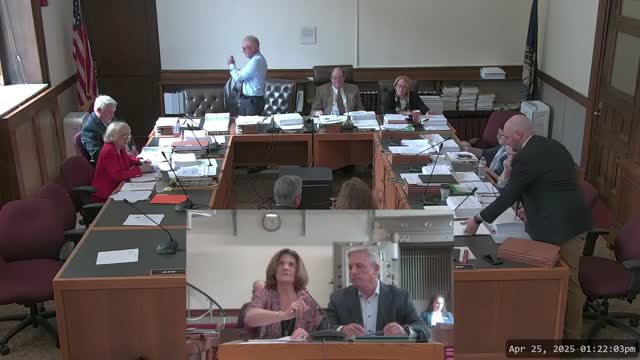University System warns a $57.6M House reduction would force deep restructuring
April 25, 2025 | Senate , Committees , Legislative, New Hampshire
This article was created by AI summarizing key points discussed. AI makes mistakes, so for full details and context, please refer to the video of the full meeting. Please report any errors so we can fix them. Report an error »

Catherine Provencher, chancellor of the University System of New Hampshire, and Mike Pilate, board chair, told the Senate Budget Committee that the House’s proposed reduction to higher‑education funding would force major structural changes across the system.
“The House adopted budget reduces state investment by 30% between the current biennium and the next biennium,” Provencher said, putting the figure at about $57,600,000 over the biennium when one‑time funds are excluded. The governor had proposed a roughly 4% reduction; the university leaders said the deeper House cut is “unsustainable.”
Why it matters: state support subsidizes in‑state tuition and statutory programs that keep college affordable for New Hampshire residents and underpin Cooperative Extension, the Agricultural Experiment Station and other services. Provencher said $81,000,000 of current state support offsets in‑state tuition (about $7,300 per student), and that without the state subsidy the average net tuition for a New Hampshire student would rise toward out‑of‑state levels.
The university system presented data on enrollment trends and projections: system enrollment dropped from 30,400 in 2019 to about 26,440 in 2025 (a 13% decline), and the board’s model projects a further decline to about 23,700 by 2030 (an additional 12% decline). The chancellor said the system models a 1.5% annual enrollment decline and rising discount rates, and that projected margins could swing from a $13 million shortfall this year to $58 million in 2030 under current assumptions. “We are losing nearly a quarter of our enrollment over a short period of time and getting the costs aligned with that new level of revenue opportunity is a painful but needs to be strategically done,” Pilate said.
Provencher and Pilate emphasized the system’s contribution to the state’s workforce: they cited research activity at the University of New Hampshire that has reached R1 status and an annual economic impact figure the system provided of about $3.7 billion, including alumni earnings. The presentation said about 3,000 graduates entered New Hampshire’s workforce last year and that 80% of those were New Hampshire residents — a key argument for maintaining state support to retain and grow the in‑state talent pipeline.
Leaders described cost‑containment steps already taken — reduced headcount, negotiated benefits changes, early retirement offers, program rationalization and an ERP investment to coordinate administrative systems — and outlined further structural work slated to realign program delivery across campuses. They asked the Senate to restore funding to the governor’s level and to continue partnership on workforce strategies.
Ending: Provencher asked senators to consider the longer‑term implications of deep cuts while the system navigates a demographic “cliff” in college‑age populations. Pilate and other witnesses said they will continue to provide data and engage with lawmakers as the budget process proceeds.
“The House adopted budget reduces state investment by 30% between the current biennium and the next biennium,” Provencher said, putting the figure at about $57,600,000 over the biennium when one‑time funds are excluded. The governor had proposed a roughly 4% reduction; the university leaders said the deeper House cut is “unsustainable.”
Why it matters: state support subsidizes in‑state tuition and statutory programs that keep college affordable for New Hampshire residents and underpin Cooperative Extension, the Agricultural Experiment Station and other services. Provencher said $81,000,000 of current state support offsets in‑state tuition (about $7,300 per student), and that without the state subsidy the average net tuition for a New Hampshire student would rise toward out‑of‑state levels.
The university system presented data on enrollment trends and projections: system enrollment dropped from 30,400 in 2019 to about 26,440 in 2025 (a 13% decline), and the board’s model projects a further decline to about 23,700 by 2030 (an additional 12% decline). The chancellor said the system models a 1.5% annual enrollment decline and rising discount rates, and that projected margins could swing from a $13 million shortfall this year to $58 million in 2030 under current assumptions. “We are losing nearly a quarter of our enrollment over a short period of time and getting the costs aligned with that new level of revenue opportunity is a painful but needs to be strategically done,” Pilate said.
Provencher and Pilate emphasized the system’s contribution to the state’s workforce: they cited research activity at the University of New Hampshire that has reached R1 status and an annual economic impact figure the system provided of about $3.7 billion, including alumni earnings. The presentation said about 3,000 graduates entered New Hampshire’s workforce last year and that 80% of those were New Hampshire residents — a key argument for maintaining state support to retain and grow the in‑state talent pipeline.
Leaders described cost‑containment steps already taken — reduced headcount, negotiated benefits changes, early retirement offers, program rationalization and an ERP investment to coordinate administrative systems — and outlined further structural work slated to realign program delivery across campuses. They asked the Senate to restore funding to the governor’s level and to continue partnership on workforce strategies.
Ending: Provencher asked senators to consider the longer‑term implications of deep cuts while the system navigates a demographic “cliff” in college‑age populations. Pilate and other witnesses said they will continue to provide data and engage with lawmakers as the budget process proceeds.
View full meeting
This article is based on a recent meeting—watch the full video and explore the complete transcript for deeper insights into the discussion.
View full meeting
